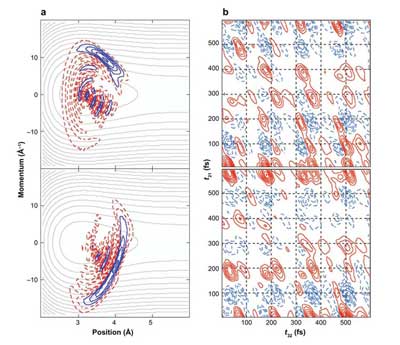Ordered by weight (if set) and creation date.
Research
My group works on the theory and simulation of time-resolved optical spectroscopy. Time-resolved optical spectroscopy on the ultrafast (femtosecond) timescale affords a uniquely powerful means to probe in real time — and also to influence — the course of molecular processes in the gases, liquids, solid materials, and biological macromolecules. Progress in this area requires direct collaboration between theoretical and experimental investigators because the systems of interest can be complex — often involving multiple electronic states, induced motion in many interatomic modes, and a complicated interplay between molecular dynamics and optical interactions — and because experimental capabilities are progressing rapidly. Although the signals are rich and informative, they’re challenging to simulate and interpret!
We are helping to develop the basic theory of wave-packet interferometry (WPI) — a form of nonlinear spectroscopy using sequences of ultrashort pulses with specified optical phase relationships — to gain direct experimental information at the level of time-dependent quantum mechanical wave functions (rather than probability densities). Our results indicates that it should be possible to use WPI as a form of analog computation to experimentally determine the evolving nuclear wave function of a polyatomic molecule driven by a short laser pulse of arbitrary temporal shape. Recent simulations of wave-packet reconstruction in the E-state of gas-phase Li2 (in which vibrations and rotations cannot be dynamically separated) demonstrate the capacity of WPI to determine the state of a realistic multi-dimensional quantum mechanical system. Our theoretical work in the area of wave-packet interferometry is taking place in collaboration with experimental groups at Oregon and elsewhere.

We are also very excited about the prospects for applying optical control and WPI to electronic energy transfer, a key process underlying biochemical energy-generation in photosynthesis and photovoltaic power generation. In addition to completing a comprehensive analysis on the use of WPI with polarized laser pulses to reveal amplitude-level information on the coherent vibrational dynamics accompanying electronic excitation transfer, we are carrying out realistic simulations on various model energy-transfer complexes. Our treatment puts forward an original explanation for the previously puzzling appearance of coordinated vibrational quantum beats in parallel and perpendicular emission channels in time-resolved polarized emission from the bacterial photosynthetic light-harvesting complex LH-1. These findings give strong hints for strategies to control the spatial transport of electronic excitation via external laser control of intra- and inter-chromophore vibrations.
Another area of current activity is in the simulation of condensed phase molecular processes by means of the reduced dynamical descriptions of Redfield theory and other relaxation-theory treatments along with approximate wave packet-based descriptions of lattice-mode dynamics. We have been able to propose, analyze, and simulate in detail a method for distance-sensitive intermolecular communication via coherent lattice waves between different types of molecular “impurities” in cryogenic matrices. The approach envisions the detection of short-pulse electronic excitation of one kind of substitutional impurity by way of time-resolved coherent anti-Stokes Raman scattering (tr-CARS) difference measurements on guest molecules of another type. The predicted difference signals show step-like switching behavior of a kind not usually seen in ultrafast spectroscopy. This work dovetails nicely with ongoing experimental work in the area of matrix-isolation spectroscopy.
